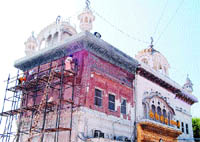 Amritsar, Punjab: The executive committee of the Shiromani Gurdwara Prabandhak Committee (SGPC) is all set to decide on the way to preserve gold foils related to the period of Maharaja Ranjit Singh.
Amritsar, Punjab: The executive committee of the Shiromani Gurdwara Prabandhak Committee (SGPC) is all set to decide on the way to preserve gold foils related to the period of Maharaja Ranjit Singh.
Sikh intelligentsia are of the view that the gold foils which are of heritage value as they were prepared and plated during the rule of the legendary king who had taken personal interest in completing the project, must be preserved in a befitting manner for posterity.
They opined that the foils must be preserved for public viewing in a museum.
Meanwhile, 3,278 gold foils and sheets have been lying in a sealed room on the premises of the Golden Temple since they were taken off from Harmandar Sahib after the UK-based Guru Nanak Nishkam Sewak Jatha (GNNSJ) had initiated regilding the upper portion and domes of the Golden Temple with about 500 kg of gold in 1994.
They are raising questions on the efficacy of protection and preservation of foils. It is apprehended that the proper conservation method might not have been adopted.
SGPC secretary Dalmegh Singh said the executive committee would decide on the gold foils and sheets and make sure whether they were being preserved safely in sealed rooms of the complex.
The jatha had arranged artists and master craftsmen from Muradabad, Varanasi, Agra and Makrana (Rajasthan) so as to retain the intricate, precise decorative nature of the embellishments.
Even the craftsmen were given a copy of the interior of Harmandir Sahib before commencing work. The regilding work was initiated after a gap of 170 years as Harmandir Sahib had assumed the name of Swarn Mandir (Golden Temple) when Maharaja Ranjit Singh got the gold plating of the shrine done.
However, the jatha had halted the second phase of regilding the inner portions of the temple after a tussle broke out in the Akali factions led by Parkash Singh Badal and Gurcharan Singh Tohra in 1999.
The UK-based jatha had taken the step after its members had to undergo a lot of inconvenience for completing the regilding work
Though the work was entrusted to the GNNSJ in 1994, it actually took off on February 3, 1995, by Panj Piaras
Meanwhile, the pace of restoration work at Darshani Deori of the Golden Temple was reduced due to recent spells of rain. The restoration work was handed over to a private company run by conservation expert Munish Pandit, Director, Sanrakshan. The experts are conserving the building in a traditional way in which cement is not used.
A Sikh devotee, who did not want to be identified, had promised to bear the entire cost of the renovation work at the Darshani Deori. More than Rs 51 lakh would be spent on the work. Earlier too, an unidentified Sikh had promised to bear the entire cost of the ongoing conservation of Baba Atal.
Protection from gases
With a view to protecting gold plating and of heritage value building of the Sikh temple, the district administration converted surroundings of the Golden Temple into a smoke-free zone by replacing coal-fed hearths of goldsmiths with LPG connections.
The district administration had taken the decision after alarming reports regarding damage to the holiest Sikh shrine due to rising pollution. While the demarcation of the pollution-free zone around it, in which no vehicle would be allowed and all activities that create smoke would be barred, is yet to be done.
Reports by the Central Pollution Control Board (CPCB) and the Punjab Pollution Control Board (PPCB) have confirmed negative effects of pollution on the Golden Temple.
The step would help prevent the corrosion of gold plating over and inside the building of the sanctum sanctorum. The PPCB had also mooted the idea to ban the use of all fuels other than LPG by hotels and dhabas in the walled city to reduce pollution.
Miniature paintings and gold plating were under threat from harmful gases, experts add.
Source: TNS
 Sikh Sangat News Celebrating Sikh culture and sharing Sikh voices
Sikh Sangat News Celebrating Sikh culture and sharing Sikh voices
